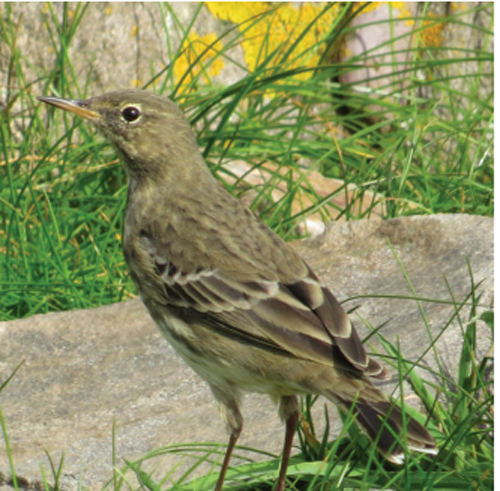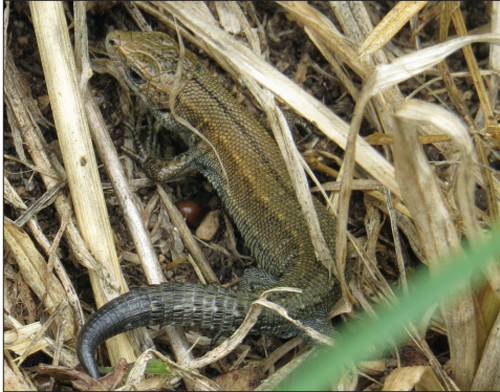| November
/ 2019 - Michael Ryan
|
| A
friend was driving us to Dingle on the same day that Hurricane Lorenzo
was due to hit land so, paying heed to the warnings, we thought it safer
to stop over at her house in Tipperary where we had a cosy night with
mercifully little disturbance from the expected wind and rain. Next
morning after breakfast I was warming myself in front of the fire in
the room adjoining the kitchen when something flew across the room.
At first I thought it was a bird then realised it was a bat which circled
between the two rooms before landing on the back of a curtain. The rooms
are divided by a sliding glass door and we’d been inspecting its
smooth running minutes before so we suspect the bat may have been hibernating
or roosting beside the top rail and we had disturbed it. The initial
reaction was to catch it and release it since a neighbour’s Labrador
was snoozing on the settee and, though showing very little interest
in our bat capturing attempts, the dog may have later found the little
creature which by now was almost at floor level though still firmly
grasping the curtain.
I was able to ease it off the curtain and hold it in my hand, its tiny heart pounding. It was probably a Pipistrelle, a species of bat which frequently roost in houses. You might think bats would have a leathery skin but it was pleasantly soft and furry to hold though its tiny teeth were very sharp which it demonstrated by little bites on my hand. I had thought to release it outside but our friend who had experienced roosting or hibernating bats in her house before told me it might be disorientated by being released into daylight and strong winds. On a previous occasion she’d found another bat entangled behind a picture frame. She’d been able to feed it liquid which it lapped up then quite happily clasped on to her Aran sweater as she walked around the house. She tucked this one gently into a towel and left it alone in a room till it settled down and later we took the little bundle into a derelict cottage and left it on a shelf. The house we were overnighting in is usually unoccupied and the bat wouldn’t have any way of getting out if the weather was mild and it wanted to hunt so the old abandoned house was a much better option where it could come and go at will through open roof and windows which facilitate at least three pairs of nesting swallows during the summer. It seemed calm and settled and hopefully it would find a safer roost there for the winter. We were glad we’d delayed our journey since the next day when we arrived at the Dingle Peninsula it was drenched in sunshine. |
|
We
drove to Dunmore Head and stopped at a picnic bench overlooking
a spectacular vista of sea and islands, a perfect spot to eat a few
snacks. We were joined there by a surprising visitor when we were approached
by a Meadow Pipit. Normally a shy bird of farms, elevated land and mountains
which wouldn’t normally be found near human habitation this individual
was almost indifferent to us, approaching within inches and darting
between our feet where we threw it a few crumbs. Behind us on Dunmore
Head a number of those exclusively coast dwelling members of the crow family, the Chough, flew out over the cliffs. With a long curved red bill and red legs the Chough (pronounced chuff) is supposedly named after the sound of its call though I can never reconcile the sharp, almost metallic, call it makes with the soft pronunciation of its name. Although thankfully Hurricane Lorenzo didn’t bring as much havoc as feared it did bring to Ireland a number of birds from the United States who would have been migrating south but were blown off course and carried across the Atlantic. It’s not uncommon to get a few American birds every autumn but these winds carried in some surprising species and the rarest was a unfortunate Least Bittern, the first ever record for this species in Ireland which turned up in a garden in Kerry. The poor creature only survived a short while after being found but a lot of other US species were spotted around the country including a Baltimore Oriole, a Black and White Warbler, a Common Nighthawk in Ballymena and a handful of Red-Eyed Vireos. These particular birds were identified by birdwatchers who knew what they were looking at but undoubtedly there must have been numerous other birds blown in who went unseen. It’s extremely unlikely these birds will recross the Atlantic and find their original flight path, they might head south to Africa instead of going to South America but basically they’re lost forever which is sad. |
 Meadow Pipit visiting picnic tables at Dunmore Head Image: M. Ryan |
| |
|
 Juvenile common Lizard on Dalkey Hill Image: M. Ryan |
I’d
reached the top of the steps going up from the mid-level of Dalkey quarry
and stopped to get my breath back when I heard the deep resonant call
of a raven behind me. There was a flock of crows wheeling over the quarry
and I expected to see among them the much larger shape of a raven being
mobbed but then realised they were in fact all ravens ( an ‘Unkindness’ ),
a great cacophony of croaks emitting from them. I counted them a few times
until I was certain of my count. There were 15 of them, a very impressive
number though I’d seen big flocks before, 29 in one group, over
Dalkey, nearly always in Autumn. Whether they were family groups or juvenile birds who haven’t yet paired and established a territory I’ll never know but they were an impressive sight. I continued my walk after viewing the flock of ravens and on the other side of the hill overlooking Killiney Bay three swallows winged past, skimming a few inches above the gorse, almost certainly the last of their species I was to see this year creature which would be soon disappearing from sight till next spring is our only native reptile the Common Lizard not heading south of course but hibernating. By November they should have already tucked themselves away for the darkest coldest months but on one day in early October we saw five individual juvenile lizards on the hill. |
DALKEY HOME PAGE | DALKEY COMMUNITY COUNCIL | DALKEY HERITAGE COMPANY | CANNONAID


